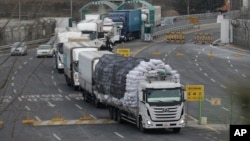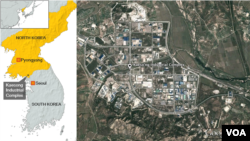South Korean factories that were forced to halt operations in North Korea’s Kaesong Industrial Complex are asking the Seoul government to compensate them for their losses.
The South Korean government suspended all activities at the industrial zone it operated jointly with North Korea, to punish the Kim Jong Un government for its recent nuclear test and latest long-range rocket launch.
The Corporate Association of Kaesong Industrial Complex represents the 123 small and medium South Korean manufacturing companies that operate there and were forced to close.
Estimated losses
The organization estimates its initial losses of assets and raw material to near $644 million (820 billion won).
When announcing the closure of the Kaesong complex, South Korean President Park Geun-hye said the government would offer aid and support to the affected companies.
“By utilizing insurance from inter-Korean cooperative funds, the government will quickly offer up to 90 percent of [the] investment cost for the Kaesong Industrial Complex,” Park said.
The Kaesong association, however, said the insurance will only cover $220 million (280 billion won) of their losses.
The group has been in talks with the South Korean government to determine fair compensation, but so far the two sides remain far apart.
“The government did not say we are exaggerating the amount, but they said it has not been objectively proven,” said Jeong Gi-seob, chairman of the Corporate Association of Kaesong Industrial Complex.
South Korea’s Unification Ministry Monday issued a statement defending the shutdown of the complex and said it is offering a range of tax deductions, loans and other support to affected business
“The government has been conducting one-on-one site visits for each company and preparing measures tailored for companies by listening to their requests,” the Unification Ministry said in its statement.
Fall into disrepair
The closure of the faculty put 54,000 North Korean employees out of work and cut off the flow of about $100 million a year into North Korea. South Korean officials said 70 percent of Kaesong funding, paid in U.S. dollars, was used to finance the North’s illicit nuclear weapons program.
After the closure of the facility was announced, Pyongyang imposed military control of the site, froze all assets of the Kaesong companies, and deported the remaining South Korean managers and staff still there.
The Kaesong association criticized the sudden closure it said violated a 2013 joint agreement to maintain a stable operation, unimpeded by political disagreements or provocations.
Seoul, however, said the existential threat to national security and public safety posed by Pyongyang’s defiant pursuit of nuclear weapons justified the harsh and sudden response.
South Korea cut electrical power and water to the Kaesong complex, making it very difficult for North Korea to utilize the facilities. If the complex remains unused for six months, some operators say, rust will set in and the equipment will fall into permanent disrepair.
Permanent closure?
The Kaesong corporate association is asking for the complex to be re-opened, but that seems highly unlikely given the increasing diplomatic and military tensions in the region.
Since 2006 the U.N. Security Council has imposed increasingly severe sanctions on North Korea for developing nuclear weapons and ballistic missile technology.
This week, the U.S. is expected to approve the strongest set of sanctions yet against the Pyongyang government, intended to cut off the trade and funding of North Korea’s nuclear program and its military, and to target the North Korean leadership and officials directly involved in these illicit activities.
The Kaesong complex was once part of a range of assistance projects meant to build trust between the North and South. But support in the South for unqualified engagement faded as Pyongyang continued its defiant pursuit of nuclear weapons and continued to initiate provocations.
Other South Korean aid programs were halted and sanctions imposed against North Korea in 2010 after Seoul accused Pyongyang of sinking a South Korean warship and killing 46 sailors.
Youmi Kim in Seoul contributed to this report.
















